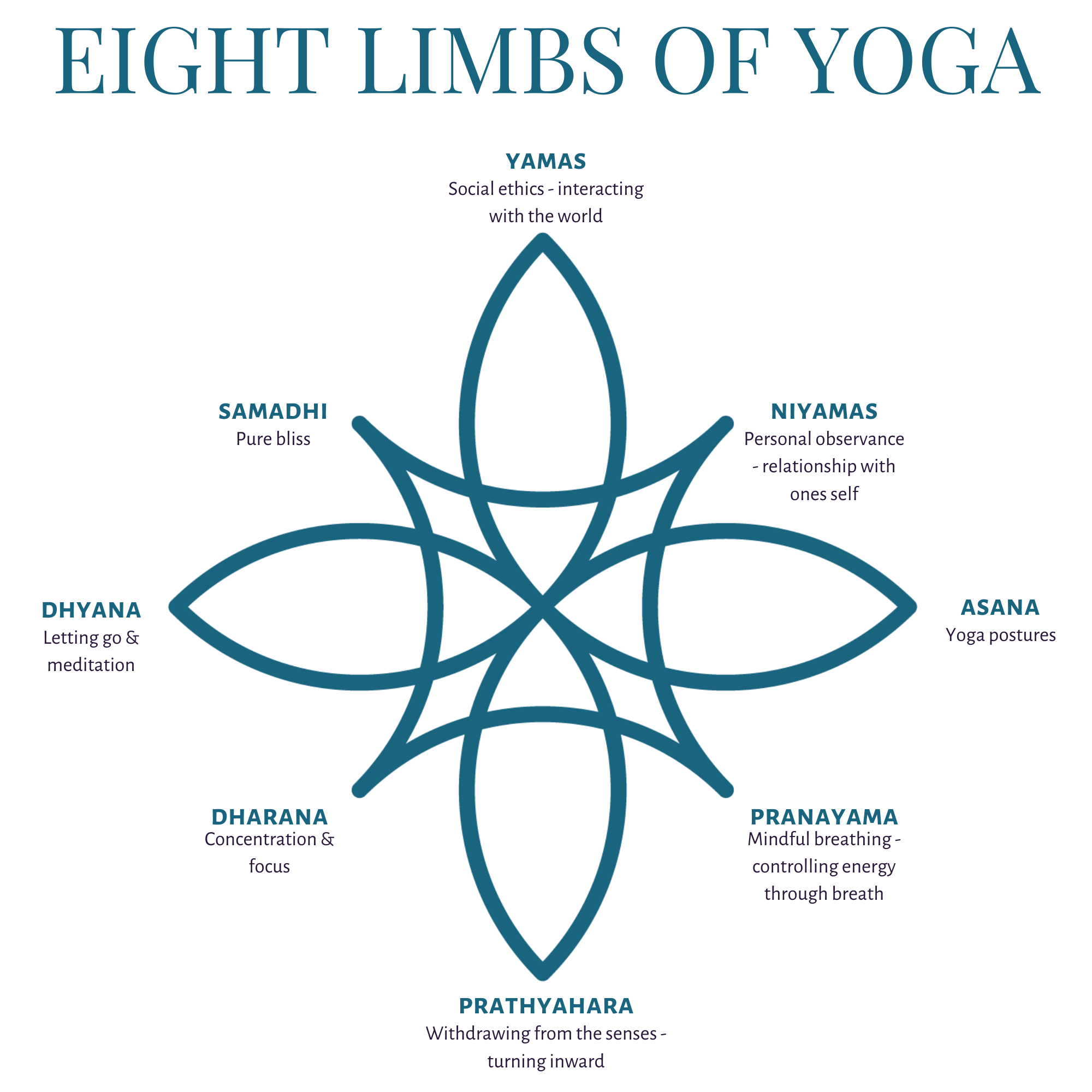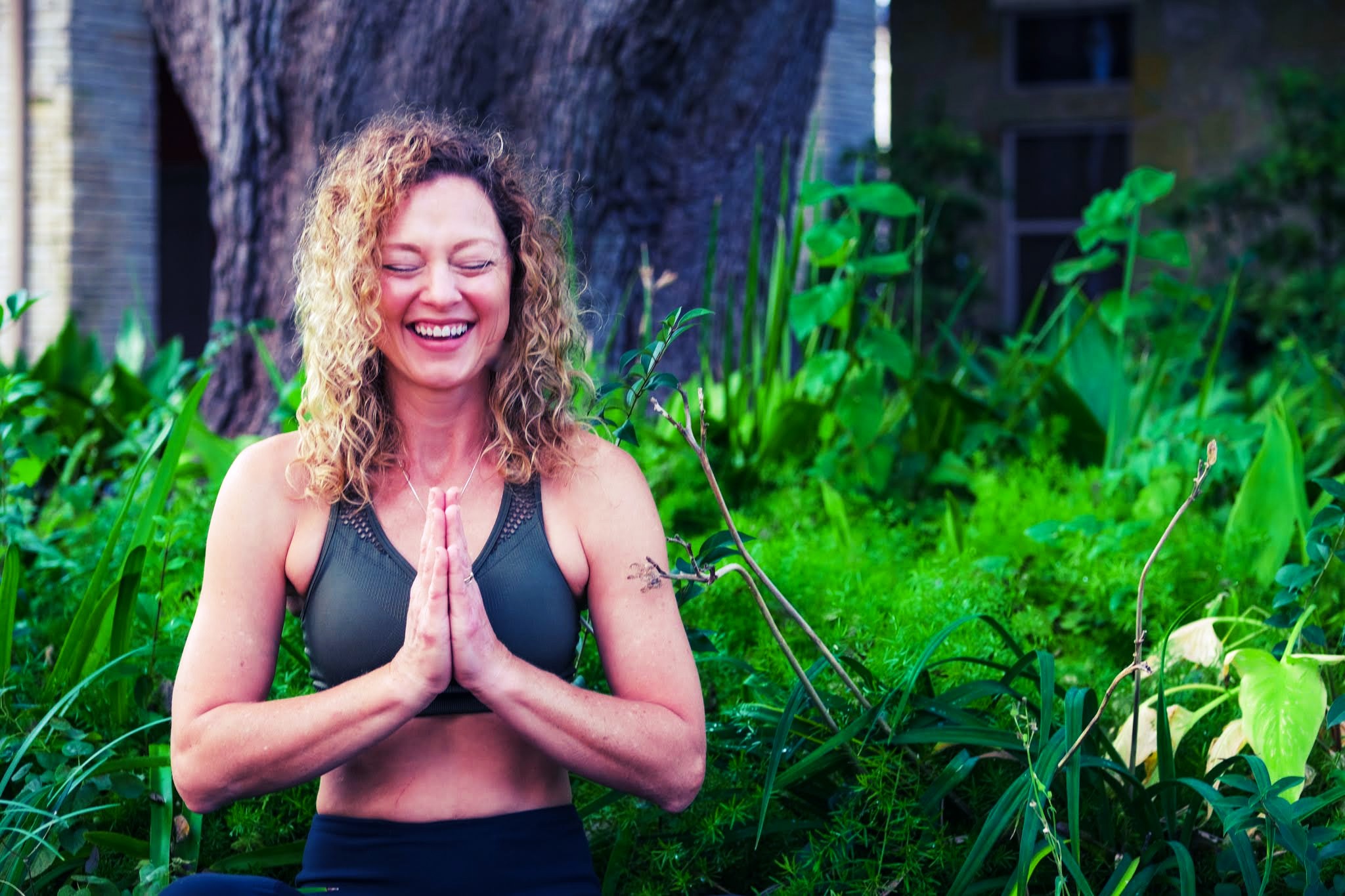| What do you think of when you hear “yoga”? A form of movement? Meditation? Stretching? Flexibility? Spiritual? Traditional yoga is more than just what you do in a one-hour class. Your experience from that class can carry over into the other 23 hours of the day. We’re going to be exploring more about yoga, on and off the mat, specifically, the Eight Limbs of Yoga. Each limb describes a different aspect of a yoga practice, all leading towards freedom and enlightenment.1 |

| You’ll often see and hear Sanskrit terms when practicing yoga. Sanskrit is an ancient Indo-Aryan language that is the classical language of India and of Hinduism. Yamas Social ethics – interacting with the world There are 5 yamas: Ahimsa – non-harming or non-violence This is not harming others or ourselves, whether it be physical, or with words or thoughts. Being kind is a choice. Being harmful is a choice. You get to choose how you will treat others and yourself. Practicing treating yourself with kindness will spread to treating others with kindness. Satya – truthfulness We know to tell the truth. We hope that others are being true to us. Are you being true to yourself? Practice sitting with yourself without judgement and finding what is true to you. Asteya – non-stealing This is not just about the act of physically taking a possession from someone. This could mean taking someone’s time, energy, attention, ideas, or joy. We can take from others when we feel that we are lacking something. Nurturing yourself can help you see that you are enough and you have enough. Brahmacharya – the use of energy How are you using and directing your energy? Is it on something that is true to you, or are you trying to impress others? Understanding our truths, and our physical, mental, emotional needs, can help with directing the use of our energy. Aparigraha – non-attachment There may be certain physical items, ideas, or expectations that we hold on to for various reasons. Those clothes in the closet that you keep because one day you may wear them again, a person from the past, or negative thought patterns. Letting go can be hard, but it can also be freeing and allow you to enjoy the present moment. |
Niyamas
Personal observance – relationship with ones self
Like the yamas, there are 5 niyamas:
Saucha – Cleanliness, Purity
Have you heard the phrase “a cluttered room is a cluttered mind”? It’s very true. Having a clean environment gives us a sense of calm and clarity.
A self-care cleansing routine for your body is a way to show yourself some love and care.
Self-massage, fragranced soaps, and lotions, or just standing in the shower imagining that all of our stresses and troubles are washing away
Cleansing your thoughts and removing the negativity and replacing that with compassion and understanding
Santosha – Contentment and gratitude
We’re often so busy or distracted with so much going on that we don’t take the time to just be present. Learning to pause, and taking the time to just sit with yourself, you can open your mind and your heart and find contentment and gratitude with who you are, as you are, and where you are in life
We are often critical of ourselves and compare ourselves to others and it can be hard to not compare our journey with others, but this can cause a lack of contentment and gratitude. Social media has a tendency to open us up to compare ourselves and our journey with others. If you find yourself in this situation, consider cleansing your feed and removing any accounts that aren’t serving you.
In a yoga class, you may see that another yogi can do more advanced poses or are more flexible. Try being present on your mat to what your body can do by understanding your abilities and limits, which over time, can change.
Tapas – Endurance and acceptance
Change is inevitable and it can also be difficult. When you are presented with a difficult situation, approach it from a place of love and acceptance instead of fear. Moving through challenges teaches us lessons.
On your mat, you may be challenged to explore a pose that is out of your comfort zone. Cultivating the tapas in your asana practice could mean that you embrace the challenge and being disciplined in showing up regularly to improve your skill and accepting that it’s okay to not be “perfect”.
Svadhyaya – Self-study and self-awareness
To take a step in the right direction, we first have to know where we are. When we begin to really take a look at our values, we may find that our actions are not in alignment with those values. By paying attention we can begin to become aware of the things that do not serve us or may be causing us harm.
Svadhyaya on the mat may make you aware of your breathing patterns, where you hold tension, and thoughts may arise that are uncomfortable. Ask yourself what you can learn from this awareness.
Ishvara Pranidhana – Surrender
We often want to be in control of what we experience – our outcomes, our career, our bodies, discomfort, and so many other things. The thought of letting go and releasing control can be a very scary thing, but we can begin to surrender to what is and remain open to our experiences.
On the mat, after a long hard day, you may find that you don’t need to push yourself beyond boundaries and surrender to what it is your body is asking you for.
The relationship with yourself is the most important relationship you will ever have.
Asana –Yoga postures
This is probably one of the most familiar limbs of yoga and maybe why you attend a yoga class.
The goal is not to see how much you can twist and bend or do a headstand. The goal is to be able to find steadiness and comfort in the pose.
Instructors lead us through connecting postures, releasing energy, releasing any tension or discomfort, connecting us to the body, mind, and breath until we arrive at savasana where we find calmness and stillness. The postures lead to sitting for meditation and pranayama.
Pranayama -Mindful breathing – controlling energy through breath
Our bodies breathe naturally and we may not put much thought into this, but our breath gives us life. If we do think about our breath and begin to control it, it can affect our physiological and cognitive responses to situations.
In other words, we can change the state of our mind and body just by breathing mindfully. If we’re stressed we can relax our body and calm our mind just by taking a few slow deep breaths.
If you would like to learn more about breathwork, you can read more about it in this blog post. Next time you practice asana, bring attention to your breath and take notice of the breathing pattern and experiment with controlling your breath.

leave a comment
share
share
share